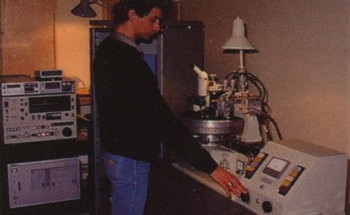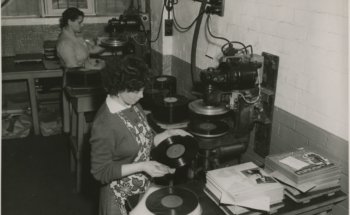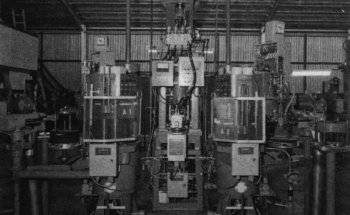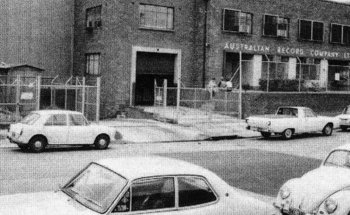Steve Smart is one of the few mastering engineers in Australia who started his career as a Vinyl Cutting Engineer (back at CBS records in the 1980’s). Based on his experience of seeing Vinyl come, go, and come back again, we asked him a few questions about Mastering for the format in the 21st Century.
This is the first of a three part series:
- From the Desk of Steve Smart: Mastering for Vinyl – Part 1
- From the Desk of Steve Smart: Mastering for Vinyl – Part 2
- From the Desk of Steve Smart: Mastering for Vinyl – Part 3
To book Steve Smart for your mastering project, click here or contact Lynley on 02 9698 5888 or mastering@studios301.com
Vinyl vs CD vs Hi-Res files
The difference between vinyl and CD in the very beginning was that the CD was deemed to be indestructible and you didn’t have the surface noise of vinyl, you didn’t have that crackle. They were immune to dust because they were read by a laser and so all of the – you know the comparisons – that’s why I think they were welcomed so readily ‘cause you could (sort of) be rough with them and abuse them a little bit. Also in the early stages, the dynamic range was far superior to vinyl and the frequency response was restricted, but also far superior to vinyl. It had a frequency of 20 Hz to 20 kHz. With Vinyl, you couldn’t really get away with too much low frequency and you couldn’t get away with too much mid frequency and so a lot of vinyl records don’t have a lot of bottom end.
Is there a general frequency range that vinyl can reproduce?
Well you can get away with 20Hz to 20kHz on vinyl, but the mechanical and physical constraints of cutting a 20 Hz frequency, is such a violent excursion of the groove on the record. 20 Hz on a groove produces all manner of distortion factors, just by the tracing of the groove and the tracing of the needle itself. Same for that fact with high frequencies. So if you brought the frequency range in a little bit, you could get away with a really nice sounding cut. It’s said that in vinyl, all you really had to do is get the bottom end right and everything else would fall into place.
But in CDs, all you really got to do is get the top end right and everything else will fall into place.
Is that because there is so much more high frequency content available on the CD medium?
Yeah, a lot of people say that vinyl sounds warmer. You know, what is warm? I guess it’s a colourful explanation of the way something sounds. So in warmth, I’d say that there aren’t exceptionally high frequencies just due to the limitations of the vinyl medium itself. There’s more presence, and I think the mid frequencies are catered to a little bit better. Because most of the information is in the mid frequency area anyway, a lot of cutting engineers paid particular attention to the mid frequencies just to get them right so that it sounded like a really good, level cut.
The Loudness War
I think what’s happened is that CDs got out of control. Maybe it is due to the fact that the artist/label demands it to be louder than everybody else’s master. The whole loudness war started with the 7” single and in cafés and jukeboxes because every artist wanted their 7” single to be played back in the café louder than the other records. That’s the first loudness war. But the loudness of a record or a loudness of a CD doesn’t really matter on radio or television because they have multiband limiters to take it to a certain level anyway during broadcast. And so for that fact is iTunes, it stops at a certain level. If it’s too loud, it gets turned it down. If it’s too quiet, it get turned it up.
You mean the iTunes player?
Yes, iTunes playback. The whole loudness war got really out of hand, especially when there’s only a certain amount of level you can put on to a digital device, after that it starts clipping and goes into red distortion. Digital distortion isn’t as nice as analogue distortion. It tends to end up just being a crackly annoying sound. Analogue distortion can take on some sort of interesting facets where it becomes quite pleasing. So with everyone wanting their CD louder than the next guy’s, someone ended up writing software and implementing that into devices at the hardware level, which is called “Look-Forward Limiting“. This is where the limiter basically looks at the transient’s absolute peak, or the most significant bit of the program itself, and chops it off. It just squares it into a square wave, instead of a nice sine wave.
Hence the distortion?
Hence the clipping distortion. CDs just got louder and louder and louder and of course the one thing that really started to suffer was the music itself. The dynamic range started to decrease significantly. That nice transient deluxe kind of quality of the whole high frequencies where the most energy is, started to just simply get squared off.
So CDs, I guess, now started to sound more and more and more horrible and horrible…. and horrible.
You mean harsh?

Harsh, hard, abrasive and very confronting. The basic dynamic in digital is on and off. It’s a word. It’s a 0 or a 1. The basic dynamic in analogue is loud or soft. So there’s a big difference there between the two in a way that you’re listening to them. Either your ear is switching on or off or your ear is detecting loud and soft. It goes against the grain for the brain to switch on and off. It can slowly switch on and slowly switch off.
But I think that’s what’s encouraged this resurgence in vinyl music, apart from just the pure fascination of it, is where basically you do have limitations which you’re stuck to – if you make a record too loud, it physically won’t playback. The grooves will make contact with each other and cause skipping and jumping so that record is basically a failure. The way to make a record sound loud is in sound, not just its pure level.
You mean generally, or on vinyl?
Particularly on vinyl and, I guess in generally, you can apply that as well. You can make a record sound loud, without it actually being loud, just by the choice of frequencies that you apply to it. Commonly, if you apply upper mids to a piece of music, it’ll sound louder. It’s just the way the human ear works. So you can only go to a certain level with vinyl records and then you physically can’t go any louder. Vinyl records are pretty much generally within a couple of dB, all very much the same level. And the beauty of a good cut and a bad cut is in the way it sounds, not actually it’s levels.
But unfortunately what’s going on with CDs of late has now been misconstrued. What is a good CD, is it loud or soft? Because it’s irrelevant if it sounds good or not. It’s whether it’s loud or not. I’ve been asked as a mastering engineer to just smash it. And, as a mastering engineer, that’s almost like destroying your work.
Limiting

You do what you’re instructed to do by the client, within your recommendations. But then if they bring out a CD that’s had look-forward limiting applied in the recording process and look-forward limiting applied in the online mixing process and look-forward limiting applied to the mastering process, versus something that hasn’t had any compression or limiting at all, it’s almost impossible to match that without destroying the pure sonic integrity of the music itself.
You know, there’s a lot of CDs out there that I’ve bought because I like the music, but I don’t play very often.
Because they’re too loud?
Well they’ve been, I guess, destroyed by this ever increasing need to have a loud CD. I mean, I can to listen to it but I can’t exactly be too close to the speakers. That’s probably being a little too fussy, but I’ve got to pretty much ”put the stereo on and go in the backyard” because it’s just too annoying to be too close to the speakers.
But you know, when you get a vinyl record, you are almost drawn to the speakers. You’re invited in to what’s being played for you.
So all things being equal, does vinyl sound better than CD?
I think vinyl does sound in some ways better than CD because of the limitations that the medium applies on the music. But CDs can – and do – sound better than vinyl if they are treated technically properly.
Admittedly, I’m not a big fan of the 44 kHz / 16-bit sound. I don’t really think, that in its vocabulary, it truly understands harmonics. I’ve recorded pianos on analogue and I’ve recorded pianos on digital. And the analogue recording sounds like a piano. The digital recording sounds like a keyboard.
It’s the same microphone, at the same level – I remember reading somewhere, some bizarre misconception that they didn’t really want the public to have any more capability of digital recording because it was getting far too close to the realms of military spec!
Really?
So they restricted it – Well, apart from the obvious case that you can’t really fit that much data on a one-sided 700MB-ish disc, it can only be done either at the sacrifice of the sampling frequency or at the sacrifice of the bit depth.
So there was an equal trade-off between 44 kHz, which was deemed acceptable and 16-bit, which was deemed acceptable for digital.
So what about 24/96 or any variation thereof, as opposed to vinyl?
I much prefer the sound of 88 kHz / 24-bit. I think that just seems to sound a little bit better than 96 kHz / 24-bit. To me anyway, sitting in here, I just find that there’s a little bit more subtlety about the recording itself at the 88 kHz frequency.
Why is that?
I’m not quite sure whether what I’m hearing, but there does tend to be a coldness about the 192 and 96 kHz sampling frequencies. Whether it’s paying too much attention to the real sound and not masking some details of it, and you’re actually hearing too much information, or – I’m just not sure, but 88 kHz / 24-bit is capable of recording and playing back natural sounding instruments like trumpets, and particularly wind instruments, very well. You end up hearing a lot of that natural distortion and intermodulation that you get from trumpets and trombones.
In the harmonics?
Absolutely.
So analogue doesn’t necessarily sound better than digital?
I think that, you know, it’s a personal thing. When you’re listening to vinyl as versus CD, vinyl has more inherent side effects to the music than the CD. If the digital information is properly recorded and properly mastered and played back with a much more musical and sympathetic approach to doing the job, rather than actually just flippantly slamming it down, CDs can sound better than vinyl. In fact, they do. But, you know, it’s just simply the constraints of the vinyl medium that prevent you from overdoing it, in which case, you know, there’s quite a lot of CDs out there that are overdone.
As in there’s too much room for abuse with what you can do with it?
Absolutely. There’s just far too much room for error. There is no room for error in vinyl, either it’s a good sounding record or it’s shit. And it’s quite clear and obvious. If there is a problem, physically it will not playback correctly and therefore it probably won’t get through quality control. But who’s to say what’s deemed acceptable in the days of CD mastering. There’s very little quality control. Well, [they’re] certainly not played and checked by someone when the CDs are being pressed.
Is that why we listen to our masters in their entirety before we send them out?
That’s correct.
However….
In saying that, I think that CDs can sound very much like we want them to sound. Warmer, much more in characteristic with, the sound that you get from a vinyl record. A mastering engineer who has actually cut records for a long period of time and who understands the process and has the right equipment, whether that equipment be analogue or digital, can master a record sensibly and not make it harsh and un-wanting.
Because of their experience more so than anything else?
Yes, experience.
When you’re mastering nowadays for vinyl as opposed to CD, are you taking a different approach to each master?
Yes, definitely. There’s a requirement of the way people want their stuff to sound as far a CD is concerned. And then there’s the complete no-go zone for mastering it for vinyl, where you just can’t get away with that sort of stuff. So, the difference between mastering specifically for vinyl and CD is that you have to pay very strict attention to the low frequencies. You have to whittle out all of that dangerous overly wide stereo low frequencies and you have to pay serious attention to the high frequency transients and make sure that they’re not too fast or not too abrasive or don’t contain too many extraneous unwanted high frequencies. So you, musically I suppose, smooth it over a bit and make it a little bit softer. There’s also no need whatsoever to apply any of the digital gain structuring, such as the look-forward limiting to turn it up because it’s completely useless, because there’s only a certain level you can cut that vinyl record out at, which is dictated by its duration. So then comes the artistic and loving application of compression. Whether that be analogue or digital, whichever you choose. But in good old school compression and good old fashioned limiting, it makes up this lovely musical piece of mastering. But I tend to utilise the approach of mastering for vinyl, and mastering for CD, in everything I do.
Either it sounds right or it sounds harsh and brittle. And depending on the original source recording, unfortunately some of the recordings you get aren’t really done to their best possible advantage, but you get what you’re given to work with and you try and bring the best out of that as you possibly can, with the equipment you’ve got.
When you’re mastering for CD, you’re pretty much hearing in the studio how the CD is gonna end up, right?
Very much. I mean there’s not gonna be much difference between what you’re hearing in this studio and what you’re hearing at home. CD replication and duplication is so good these days that what you give is what you get.
How about vinyl?
With vinyl, we try and make the assumption with garnered knowledge as to what’s necessary to get that song onto a piece of plastic and playing back the best it possibly can.
Is there a bit of imagination as to how ‘what you do now’ affects the final Vinyl pressing?
There is a little bit of imagination, some knowledge that you’ve gained from having done it before. But it’s also good to know exactly where you’re sending it to be cut. If you’ve already got that place in mind and you’re fully aware of their capabilities and the equipment that they use, you can pretty much guarantee that what you send them, you’ll get back. But that can’t always be the situation, particularly if you don’t have control over where it is being pressed.
Read Part 2 of this blog series here
[Steve Smart is one of the senior mastering engineers at Studios 301]
To book Steve Smart for your mastering project, click here or contact Lynley on 02 9698 5888 or mastering@studios301.com




Leave a Reply to Sameer Cancel reply